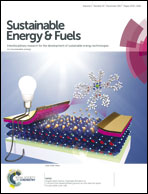Cu(ii) and Zn(ii) based phthalocyanines as hole selective layers for perovskite solar cells†
Abstract
Recently, significant progress has been achieved in the fabrication of highly efficient perovskite solar cells, while major challenges, such as the commercial viability of exotic materials and their instability, remain an obstacle. Hole transporting materials (HTMs) represent a tricky choice for the fabrication of efficient solar cells and cost ineffective Spiro-OMeTAD continues to be so far the most obvious candidate. Organometallic complexes, such as phthalocyanine metal complexes, appeared as a promising class of p-type material, since they are less expensive and more stable. Herein, we report the synthesis of a novel Cu(II)-based phthalocyanine [(tOctPhO)8CuPc 1] with 4-tert-octylphenoxy-substituted functional groups that possesses a very good solubility in a wide range of organic solvents, and thus can be applied using solution processing in a wide range of electro-optical devices. In the present work (tOctPhO)8CuPc 1 and its analogous Zn(II) phthalocyanine [represented as (tOctPhO)8ZnPc 2] were tested in mixed perovskites (FAPbBr3)0.85(MAPbI3)0.15 for the fabrication of perovskite solar cells. These phthalocyanine based HTMs exhibited competitive power conversion efficiencies and demonstrated superior stability when compared to classical HTMs.



 Please wait while we load your content...
Please wait while we load your content...